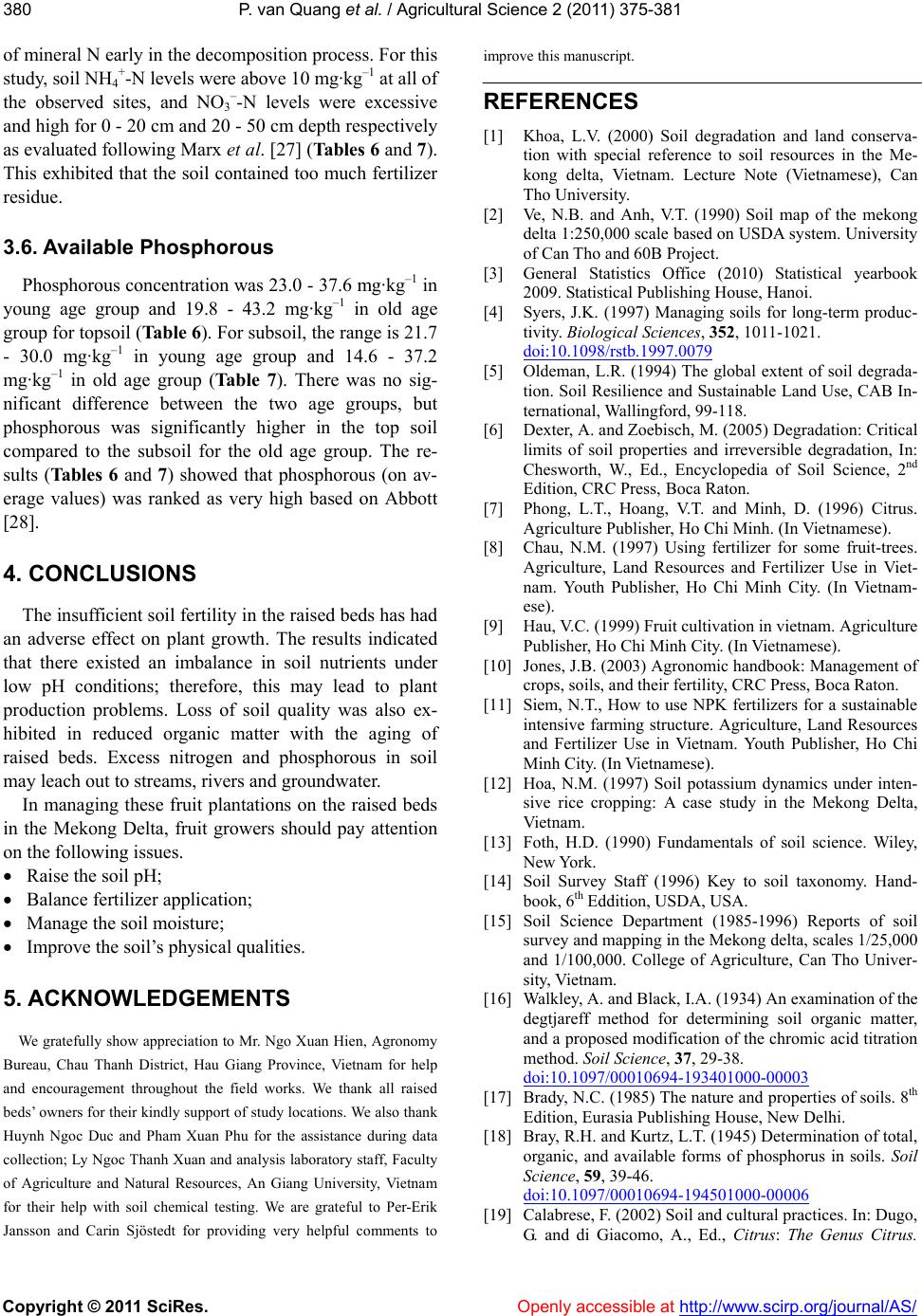
P. van Quang et al. / Agricultural Science 2 (2011) 375-381
Copyright © 2011 SciRes. Openly accessible at http://www.scirp.org/journal/AS/
380
of mineral N early in the decomposition process. For this
study, soil NH4
+-N levels were above 10 mg·kg–1 at all of
the observed sites, and NO3
–-N levels were excessive
and high for 0 - 20 cm and 20 - 50 cm depth respectively
as evaluated following Marx et al. [27] (Tables 6 and 7).
This exhibited that the soil contained too much fertilizer
residue.
3.6. Available Phosphorous
Phosphorous concentration was 23.0 - 37.6 mg·kg–1 in
young age group and 19.8 - 43.2 mg·kg–1 in old age
group for topsoil (Table 6). For subsoil, the range is 21.7
- 30.0 mg·kg–1 in young age group and 14.6 - 37.2
mg· k g –1 in old age group (Tab le 7). There was no sig-
nificant difference between the two age groups, but
phosphorous was significantly higher in the top soil
compared to the subsoil for the old age group. The re-
sults (Ta bl es 6 and 7) showed that phosphorous (on av-
erage values) was ranked as very high based on Abbott
[28].
4. CONCLUSIONS
The insufficient soil fertility in the raised beds has had
an adverse effect on plant growth. The results indicated
that there existed an imbalance in soil nutrients under
low pH conditions; therefore, this may lead to plant
production problems. Loss of soil quality was also ex-
hibited in reduced organic matter with the aging of
raised beds. Excess nitrogen and phosphorous in soil
may leach out to streams, rivers and groundwater.
In managing these fruit plantations on the raised beds
in the Mekong Delta, fruit growers should pay attention
on the following issues.
Raise the soil pH;
Balance fertilizer application;
Manage the soil moisture;
Improve the soil’s physical qualities.
5. ACKNOWLEDGEMENTS
We gratefully show appreciation to Mr. Ngo Xuan Hien, Agronomy
Bureau, Chau Thanh District, Hau Giang Province, Vietnam for help
and encouragement throughout the field works. We thank all raised
beds’ owners for their kindly support of study locations. We also thank
Huynh Ngoc Duc and Pham Xuan Phu for the assistance during data
collection; Ly Ngoc Thanh Xuan and analysis laboratory staff, Faculty
of Agriculture and Natural Resources, An Giang University, Vietnam
for their help with soil chemical testing. We are grateful to Per-Erik
Jansson and Carin Sjöstedt for providing very helpful comments to
improve this manuscript.
REFERENCES
[1] Khoa, L.V. (2000) Soil degradation and land conserva-
tion with special reference to soil resources in the Me-
kong delta, Vietnam. Lecture Note (Vietnamese), Can
Tho University.
[2] Ve, N.B. and Anh, V.T. (1990) Soil map of the mekong
delta 1:250,000 scale based on USDA system. University
of Can Tho and 60B Project.
[3] General Statistics Office (2010) Statistical yearbook
2009. Statistical Publishing House, Hanoi.
[4] Syers, J.K. (1997) Managing soils for long-term produc-
tivity. Biological Sciences, 352, 1011-1021.
doi:10.1098/rstb.1997.0079
[5] Oldeman, L.R. (1994) The global extent of soil degrada-
tion. Soil Resilience and Sustainable Land Use, CAB In-
ternational, Wallingford, 99-118.
[6] Dexter, A. and Zoebisch, M. (2005) Degradation: Critical
limits of soil properties and irreversible degradation, In:
Chesworth, W., Ed., Encyclopedia of Soil Science, 2nd
Edition, CRC Press, Boca Raton.
[7] Phong, L.T., Hoang, V.T. and Minh, D. (1996) Citrus.
Agriculture Publisher, Ho Chi Minh. (In Vietnamese).
[8] Chau, N.M. (1997) Using fertilizer for some fruit-trees.
Agriculture, Land Resources and Fertilizer Use in Viet-
nam. Youth Publisher, Ho Chi Minh City. (In Vietnam-
ese).
[9] Hau, V.C. (1999) Fruit cultivation in vietnam. Agriculture
Publisher, Ho Chi Minh City. (In Vietnamese).
[10] Jones, J.B. (2003) Agronomic handbook: Management of
crops, soils, and their fertility, CRC Press, Boca Raton.
[11] Siem, N.T., How to use NPK fertilizers for a sustainable
intensive farming structure. Agriculture, Land Resources
and Fertilizer Use in Vietnam. Youth Publisher, Ho Chi
Minh City. (In Vietnamese).
[12] Hoa, N.M. (1997) Soil potassium dynamics under inten-
sive rice cropping: A case study in the Mekong Delta,
Vietnam.
[13] Foth, H.D. (1990) Fundamentals of soil science. Wiley,
New York.
[14] Soil Survey Staff (1996) Key to soil taxonomy. Hand-
book, 6th Eddition, USDA, USA.
[15] Soil Science Department (1985-1996) Reports of soil
survey and mapping in the Mekong delta, scales 1/25,000
and 1/100,000. College of Agriculture, Can Tho Univer-
sity, Vietnam.
[16] Walkley, A. and Black, I.A. (1934) An examination of the
degtjareff method for determining soil organic matter,
and a proposed modification of the chromic acid titration
method. Soil Science, 37, 29-38.
doi:10.1097/00010694-193401000-00003
[17] Brady, N.C. (1985) The nature and properties of soils. 8th
Edition, Eurasia Publishing House, New Delhi.
[18] Bray, R.H. and Kurtz, L.T. (1945) Determination of total,
organic, and available forms of phosphorus in soils. Soil
Science, 59, 39-46.
doi:10.1097/00010694-194501000-00006
[19] Calabrese, F. (2002) Soil and cultural practices. In: Dugo,
G. and di Giacomo, A., Ed., Citrus: The Genus Citrus.